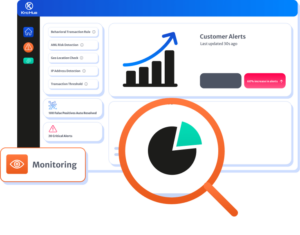Transaction monitoring is not just as a regulatory checkbox but as a guardian of your business’s integrity. By catching the red flags before they become full-blown crises, transaction monitoring helps you stay ahead of potential money laundering schemes, protecting what you’ve worked so hard to build.
Money laundering is a significant and growing threat to the global financial system, enabling the concealment of illicit gains and financing of criminal activities. As financial institutions strive to uphold the integrity of their operations and comply with regulatory requirements, transaction monitoring has emerged as a critical tool in the fight against money laundering.
When implemented effectively, transaction monitoring can detect and prevent suspicious activities, safeguarding both the institution and the broader financial ecosystem. This article explores how transaction monitoring works, its role in combating money laundering, the features of an effective system, challenges faced, and future trends in this crucial area.

Understanding Transaction Monitoring
Transaction monitoring is the process by which financial institutions track and analyze customer transactions to identify suspicious activities that may indicate money laundering, fraud, or other financial crimes.
This ongoing process involves the collection and analysis of data on a range of transactions, including deposits, withdrawals, wire transfers, and purchases. The goal is to detect unusual patterns or red flags that could suggest illegal activity.
A typical transaction monitoring system works by applying predefined rules and algorithms to transaction data. These rules may be based on known money laundering techniques, such as structuring (breaking up large transactions into smaller ones to avoid detection) or the rapid movement of funds through multiple accounts. When a transaction triggers one of these rules, it is flagged for further investigation.
Transaction monitoring is not just a best practice; it is a regulatory requirement in many jurisdictions. Anti-money laundering (AML) regulations mandate that financial institutions implement effective monitoring systems to detect and report suspicious transactions to the relevant authorities. Failure to comply with these regulations can result in severe penalties, including fines and reputational damage.
The Role Of Transaction Monitoring In Detecting Suspicious Activity
Transaction monitoring plays a vital role in identifying suspicious activities that may be indicative of money laundering. One of the key functions of transaction monitoring is the identification of red flag transactions that deviate from a customer’s usual behavior or the norms of similar customers.
These red flags could include large cash deposits, transfers to high-risk jurisdictions, or a sudden increase in transaction volume. Effective transaction monitoring systems are capable of real-time monitoring, allowing financial institutions to detect and respond to suspicious activities as they occur.
This real-time capability is essential in preventing money laundering, as it enables institutions to take immediate action, such as freezing accounts or reporting the transaction to authorities. For instance, consider a scenario where an individual suddenly begins transferring large sums of money to offshore accounts.
A robust transaction monitoring system would flag this activity as suspicious, given the unusual nature of the transactions compared to the individual’s typical financial behavior. This prompt detection allows the institution to investigate further and, if necessary, take action to prevent the funds from being laundered.
Real-world examples of successful transaction monitoring highlight its importance. In several high-profile cases, transaction monitoring systems have detected complex money laundering schemes involving multiple jurisdictions and large sums of money. These cases often involve the use of advanced analytics and machine learning to identify patterns that would be difficult to detect manually.
Key Features Of An Effective Transaction Monitoring System
To effectively combat money laundering, a transaction monitoring system must possess certain key features. One of the most important is automation, particularly the use of artificial intelligence (AI) and machine learning. These technologies enhance the system’s ability to analyze vast amounts of transaction data and identify complex patterns of suspicious activity.
AI-powered systems can continuously learn and adapt to new money laundering techniques, making them more effective over time. For example, machine learning algorithms can detect subtle changes in behavior that may indicate the early stages of money laundering, allowing institutions to intervene before the scheme fully unfolds.
Another critical feature is customization and scalability. Financial institutions vary widely in size, customer base, and risk exposure, so a one-size-fits-all approach to transaction monitoring is ineffective.
An effective system must be customizable to address the specific needs of the institution, such as tailoring rules and thresholds based on the institution’s risk profile. Additionally, as institutions grow or expand into new markets, the transaction monitoring system must be scalable to handle increased transaction volumes and complexity.
Integration with other AML tools is also vital. A comprehensive AML strategy involves multiple components, including customer due diligence (CDD), know your customer (KYC) processes, and sanctions screening.
By integrating transaction monitoring with these other tools, institutions can create a more robust and effective defense against money laundering. For example, information gathered during the CDD process can inform the parameters used in transaction monitoring, improving the system’s accuracy.

Challenges In Transaction Monitoring And How To Overcome Them
Despite its effectiveness, transaction monitoring faces several challenges. One of the most significant is the issue of false positives and false negatives. A false positive occurs when a legitimate transaction is flagged as suspicious, leading to unnecessary investigations and operational inefficiencies.
Conversely, a false negative is when a suspicious transaction goes undetected, allowing potentially illicit activity to proceed unchecked. False positives are particularly problematic, as they can overwhelm compliance teams with a high volume of alerts, many of which turn out to be benign.
This can lead to “alert fatigue,” where important alerts are overlooked due to the sheer volume of cases. To address this, institutions can refine their transaction monitoring algorithms, improve data quality, and implement machine learning models that reduce the likelihood of false positives by better distinguishing between legitimate and suspicious activities.
Data quality and management also pose challenges. Effective transaction monitoring relies on accurate and complete data. Inconsistent or incomplete data can lead to incorrect assessments and missed red flags.
Financial institutions must prioritize data management practices, ensuring that all relevant data is accurately captured, securely stored, and readily accessible for analysis. Staff training is another critical factor.
Even with the most advanced systems, human oversight is essential for reviewing flagged transactions and making informed decisions. Ongoing training helps ensure that compliance teams are equipped to recognize evolving money laundering techniques and properly interpret the outputs of transaction monitoring systems.
The Future Of Transaction Monitoring In Combating Money Laundering
As technology evolves, so too does the landscape of transaction monitoring. Emerging technologies, such as blockchain and advanced analytics, hold promise for enhancing transaction monitoring’s effectiveness.
Blockchain, with its transparency and immutability, could provide new ways to track transactions and detect suspicious activity. Advanced analytics, including predictive analytics, can anticipate potential money laundering risks before they manifest.
Regulatory trends are also shaping the future of transaction monitoring. As regulators impose stricter AML requirements and expectations, financial institutions will need to continuously improve their monitoring systems to stay compliant. This will likely involve greater use of AI, increased integration with other AML tools, and more sophisticated data analysis techniques.
Continuous improvement is essential in the fight against money laundering. As criminals develop more sophisticated methods, financial institutions must stay one step ahead by regularly updating and refining their transaction monitoring systems. This includes incorporating feedback from regulatory audits, adopting best practices, and leveraging new technologies as they become available.

Conclusion
Effective transaction monitoring is a cornerstone of any robust anti-money laundering strategy. By detecting and preventing suspicious activities, financial institutions can protect themselves and the broader financial system from the risks associated with money laundering. The key to success lies in implementing a system that is automated, customizable, scalable, and integrated with other AML tools. While challenges such as false positives, data quality, and evolving threats must be managed, the future of transaction monitoring holds promise with the advent of new technologies and regulatory developments.
To remain resilient in the face of increasingly sophisticated money laundering schemes, financial institutions must invest in and continuously improve their transaction monitoring capabilities. By doing so, they can play a pivotal role in combating financial crime and maintaining the integrity of the global financial system.
Don’t let money laundering put your business at risk. Partner with Senrab ConsulTech to implement Fusion AML, our advanced transaction monitoring system designed to keep you compliant and secure. Our experts are ready to help you enhance your AML strategy and safeguard your financial operations. Contact us today to learn more about Fusion AML!


